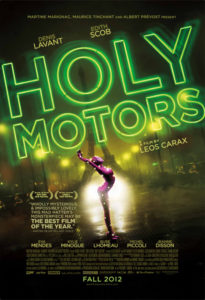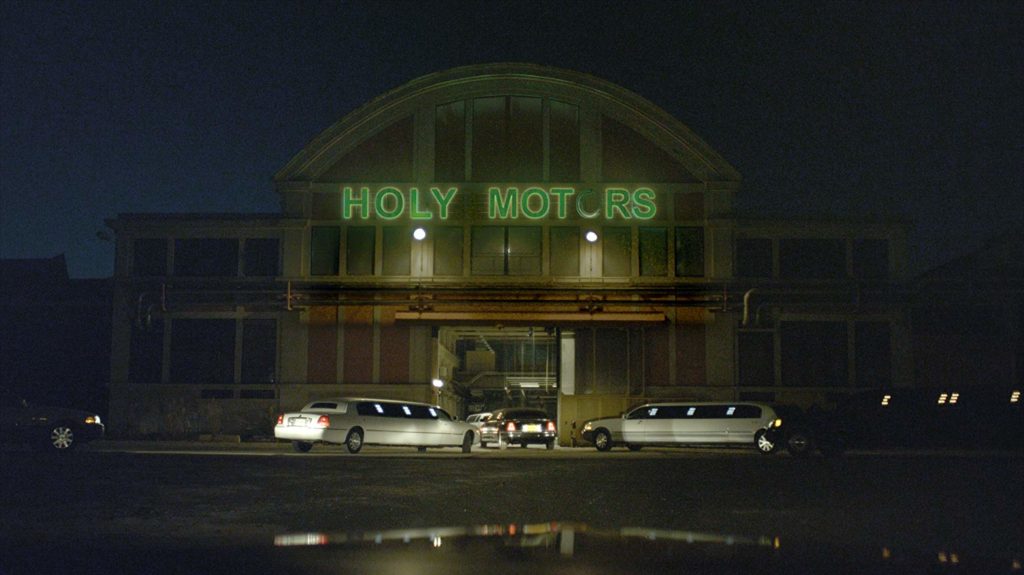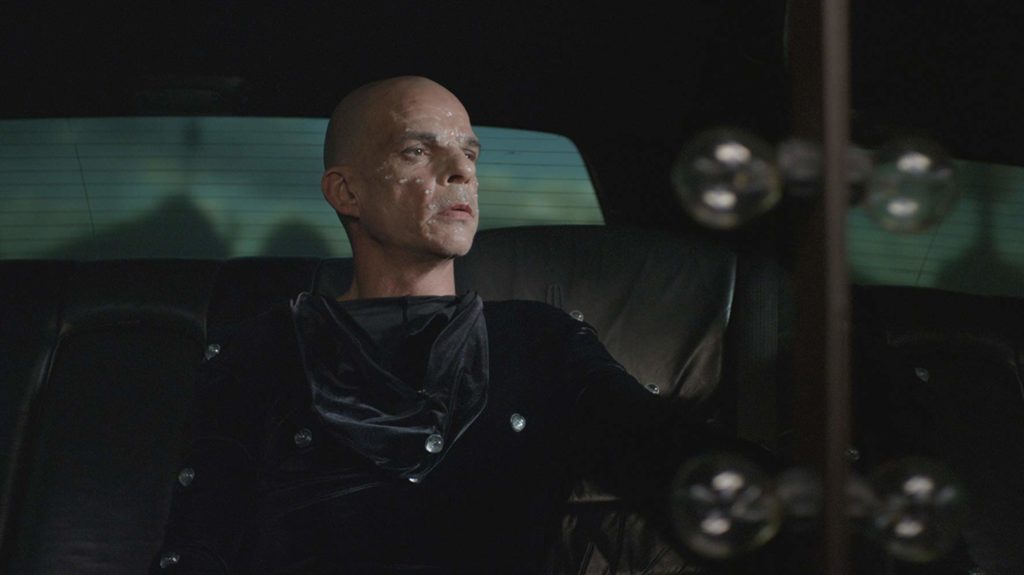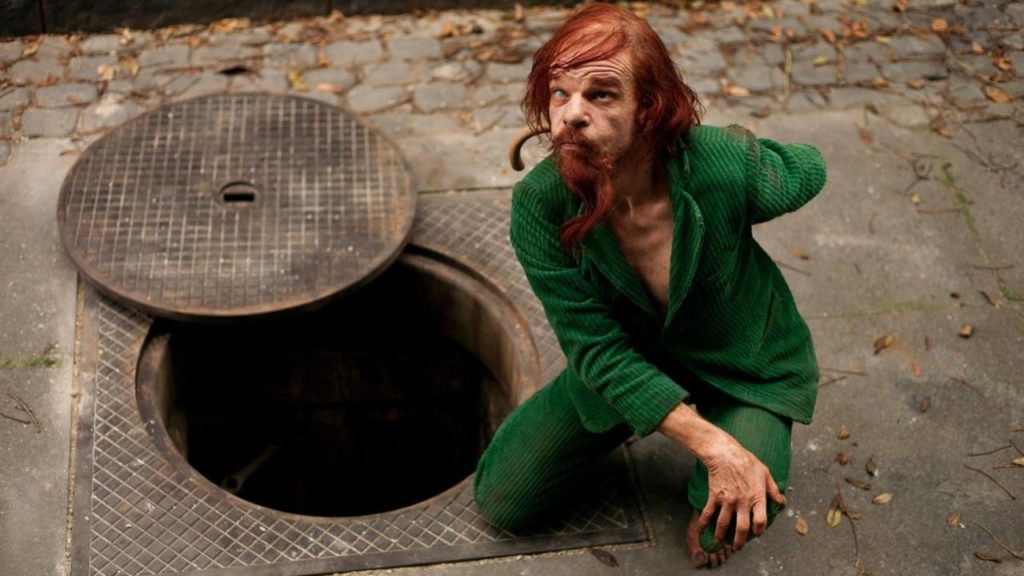Obtuse French Film Challenges the Mechanism
DIRECTED BY LEOS CARAX/FRENCH/2012

Far more statement than story, the challenging French language provocation Holy Motors isn’t just one of the most thought-provoking films of the year, it may just be film’s pending and undecoded epitaph. Call it Lynchian, call it Fellini-esque, call it “French”, just don’t call it “weird”.
It’s hard to know the place where brazen, mad oddity gives way to profound and possibly ingenious, but we do know that according to this year’s crop of cinema obscura, one gets there via limousine. A few months ago, David Cronenberg sent a bleakly blank Robert Pattinson across a terminally congested New York City on a quest for a haircut in Cosmopolis. The film, like the intentionally vague character, remained almost entirely confined to his high-tech high-finance-monitoring den of stretched vehicular luxury.
Now, audiences have the opportunity to engage Holy Motors – the brilliantly off-kilter chronicle of a whole other blank slate male character prowling the streets of a major city (Paris this time) in stretched limo glory. It is dispatched by reclusive French filmmaker Leos Carax (not his real name), and arrives to its many destinations in greater glory in an even stranger guise. Never mind that these two precisely careening limousines met in an awkward near miss at the 2012 Cannes Film Festival – the similarities truly do end there. Mostly.

Although Carax (1999’s Pola X being his previous feature) may’ve cut off Cronenberg at Cannes (screening first and thereby stealing any thunder from the respected Canadian director) the fact that his film is only now reaching North America (whereas the still noteworthy Cosmopolis, following its domestic run, retired to the garage months ago) does not make it the “loser”. His film is a cinema marvel about cinema, and cinema’s shifting tectonic film cans beneath our feet. But do not mistake this for just another sky-is-falling lament from within about the quickly dying state of tangible film – Holy Motors seeks to question our part of the altogether greater cinematic process. Why do we like to watch what we watch, and what does it mean that we so haphazardly shift the mechanisms by which we watch? (Zoetropes gave way to movie palaces which gave way to multiplexes which gave way to YouTube – Have we really risen and fallen, or just spun full circle?) What – or who – are the motors in question, and (dare we ask) why are they holy?
While answers to such questions are never made explicit (far from it!), Carax offers enough oblique “clues” (for lack of a better word) in the piecing together of this puzzling non-puzzle. If, as it is widely (and probably accurately) speculated, Holy Motors is actually about the human connection and compulsion to film, then the experience of this film becomes both tremendously eccentric (and sure, self-indulgent) and undeniably profound.
In the beginning, we see Carax himself wake up in a dark bedroom with floor-to-ceiling tree wallpaper, feeling his way around in this dark faux-forest, eventually unlocking his way into a mysterious movie theater, its patrons as still as death and – is this right? – mask clad. So, from the outset, notions of film and dreaming and even quiet meditation/transfixion meld into an odd tip of the hat to old ideas about what makes cinema mysterious and compelling. This may be merely a prologue – Carax as an actor nor the movie theater are seen again – but the stage has nonetheless been set for the journey which immediately follows.

This is the limousine stuff, the body proper of Holy Motors. Carax veteran Denis Lavant is the lead, Oscar (think the award which Lavant may just be worthy of, not the grouch), the primary presence of the film, if not a traditional main character. He is an actor, a human chameleon – taking orders and playing parts, from the shifting whims some unseen boss. All the world (or at least all of Paris) is his stage. Again and again, he emerges from his limo completely anew, like some sort of unexplained street-theater Lon Chaney. Unlike Pattinson’s money-market monitoring limo, Lavant’s is tricked out like the world’s greatest green room on wheels; stocked wardrobe racks, make-up mirrors, and putty noses and wigs. Which begs the aside question: In today’s world, which of the two is the ride to greater power over the other?
Oscar alters his appearance, his demeanor, his age, even his gender as he fulfils these vignettes. His seen-it-all driver Celine, played by Edith Scob, seemingly drops him off in different genres, as he flits from theater of the mind to crime thriller to CGI lovefest (via a coldly erotic yet empty motion capture session [complete with skintight ping pong ball suits] informed no doubt by our own collective audience lust for anti-reality spectacle) (Look no further than Lavants green screen treadmill run, screamingly firing a huge phallic machine gun into empty space!) to all too brief moments of soaring musical wonder. Veiled cinema references abound, from Modern Times to Breathless to Cocteau’s Beauty and the Beast to Carax’s own filmography (with many, many more along the way.) This is how Monsieur Oscar – and Carax – actively engages the culture.
Viewers better versed than this writer may recognize Oscar’s hairy, deranged, flower-eating wild man (unfortunately known as Merde) from Carax’s segment in a 2008 anthology film called Tokyo! In Holy Motors he’s back, bringing freakish terror to a cemetery- based glamour shoot, featuring a clearly perplexed Eva Mendes. Carax takes a moment to wallow in the improperly bemused American photographer’s fascination with Merde’s utter weirdness. “It’s so weird! It’s so weird!!!”, he marvels, as he remains fixated and content to go nowhere beyond the surface of what he’s seeing. Is this Carax leveling quick judgment on those who would embrace his work for its esoteric allure, and nothing more?

Merde hauls his belle, Mendes, off to a subterranean lair in an unforgettable (and perhaps subtly disturbing) sequence that threatens sexual assault but delivers only unfulfilled pleasure, evident from the full-on state of the beast man’s eventual full frontal (and obviously prosthetic) nudity. The whole sequence is an unlikely commentary on the unfulfilling effect of the “male gaze” and cinema’s traditional primary uses for women (sexual vessels/selfless nurturers) that would make Molly Haskell (author of From Reverence to Rape: The Treatment of Women in the Movies) proud.
The fragile boundaries between what is reality and what isn’t is thus that even when Oscar appears to be off the clock, the performance seemingly continues, all the more vitally, all the more charged. Take the key sequence in the film’s second half, which features a very Jean Seberg-esque Kylie Minogue. The two share a previously glorious but now forgotten past, punctuated by the location they wander, the once grand but now dilapidated Parisian department store, La Samaritaine. It may still have the best rooftop view of the city, but the songs sung there could only be mournful, underscoring what was great and we’ve now lost. Mannequin parts and dismal clutter now occupy the empty space where wide-eyed shoppers used to ascend to the open-air vibrancy up top. Minogue belts out, with orchestrated bombast, a song asking, “Who Were We?” Never mind the recession-era/digital era metaphor inherent in it all, the mere sight of today’s La Samaritaine is wistful enough on its own.
Holy Motors has already been dismissed as a middle-aged man’s gripe against the current state of cinema. While it may be that in part, one cannot overlook it, even as its own existence is owed to the ones-and-zeroes revolution it repeatedly questions. (For budgetary reasons, it is reported that Holy Motors had to be shot digitally, much to the apparent chagrin of its maker, who’s operated on much larger scales before.)
Make no mistake; a ride in Oscar’s limo is an uncertain one. The path is bumpy, ever changing, and no one bothers to tell you where you’re going, where you are, or why the heck. Yes, “it’s so weird!”, but yes, it’s so much more. Holy Motors may leave you fuming, it may leave you floored. With its deep, European foundation of influences and references semi-obscured, many will only grasp a fraction of it outright. Thus, it invites perplexity, multiple viewings, homework, and discussions to follow. Not all will be happy with where they end up. (“The place where limousines go at night.”) But for the adventurous cinephile, it is a ride that must be taken.

